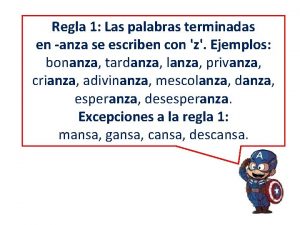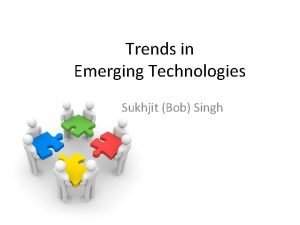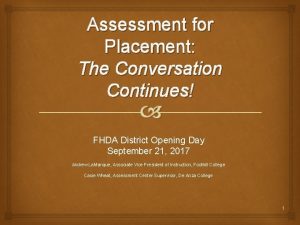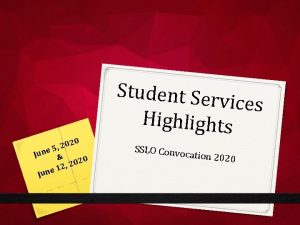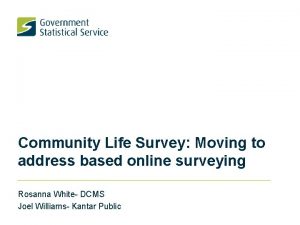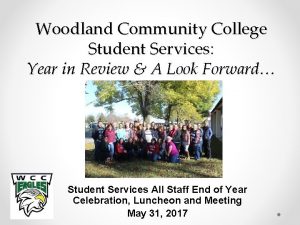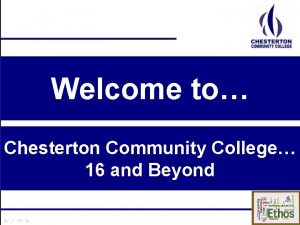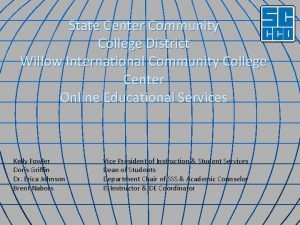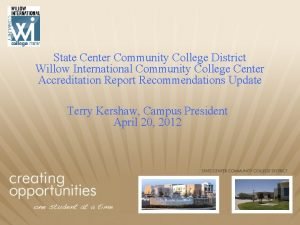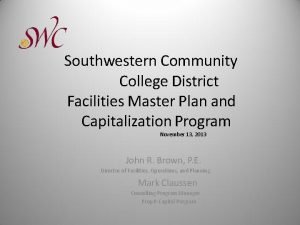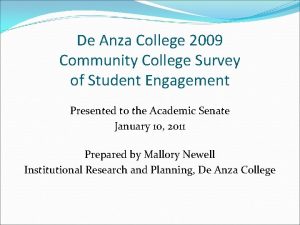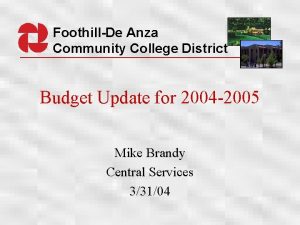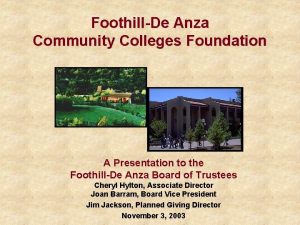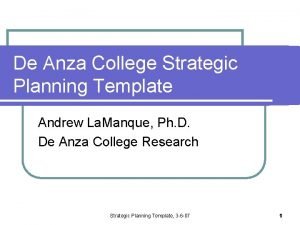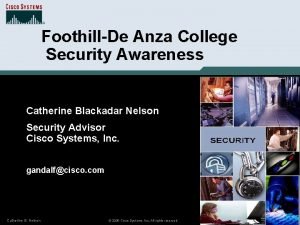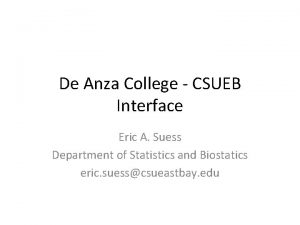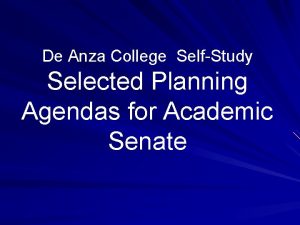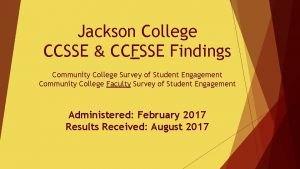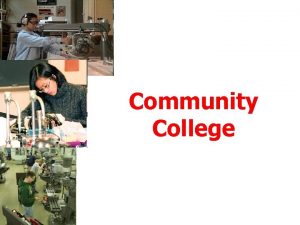De Anza College 2009 Community College Survey of













- Slides: 13

De Anza College 2009 Community College Survey of Student Engagement Presented to the Academic Senate February 28, 2011 Prepared by Mallory Newell Institutional Research and Planning, De Anza College

CCSSE Overview The Community College Survey of Student Engagement (CCSSE) was developed to: provide information about effective educational practices in community colleges, and to assist those colleges in using the information to promote improvements in student learning and persistence. The survey focuses on student engagement – the amount of time and energy that students invest in meaningful educational practices.

Survey Sample The 2009 survey was administered in class during the spring 2009 quarter. 76 course sections were randomly selected by CCSSE in which 34 sections chose to participate, which resulted in 797 of 2, 411 valid survey responses, yielding a response rate of 33%.

Active and Collaborative Learning In your experiences at De Anza during the current school year, about how often have you done each of the following? Active and Collaborative Learning 2007 2009 Diff. Asked questions in class or contributed to class discussions 2. 62 2. 74 0. 12 Made a class presentation 2. 17 2. 19 0. 02 Worked with other students on projects during class 2. 55 2. 60 0. 05 Worked with classmates outside of class to prepare class assignments 1. 96 2. 05 0. 09 Tutored or taught other students (paid or voluntary) 1. 46 1. 42 -0. 04 Participated in a community-based project as a part of a regular course 1. 39 1. 42 0. 03 Discussed ideas from your readings or classes with instructors outside of class 1. 71 1. 69 -0. 02 1= never, 2= sometimes, 3= often, 4= very often

Student-Faculty Interaction In your experiences at De Anza during the current school year, about how often have you done each of the following? Student-Faculty Interaction 2007 2009 Diff. Used e-mail to communicate with an instructor 2. 53 2. 65 0. 12 Discussed grades or assignments with an instructor 2. 29 2. 34 0. 05 Talked about career plans with an instructor or adviser 1. 85 1. 83 -0. 02 Discussed ideas from your readings or classes with instructors outside of class 1. 71 1. 69 -0. 02 Received prompt feedback (written or oral) from instructors on your performance 2. 50 2. 55 0. 05 1= never, 2= sometimes, 3= often, 4= very often

Conclusions Overall, the results from the comparison show that De Anza has improved from 2007 to 2009. Areas in which De Anza has improved include Active and Collaborative Learning and Academic Challenge. Areas in which De Anza could benefit by focusing more heavily include Student-Faculty Interaction and Support for Learners. Areas in which De Anza continues to score low in the areas of providing financial aid advising and support as well as academic and career advising and support.

This presentation is available on the De Anza Research website at www. deanza. edu/ir/ Additional documents for analysis are available upon request.

Survey Sample – Breakdown Gender: Male – 46% (49% in DA total student population) Female – 54% (51%) Ethnicity: White – 26% (24%) Asian – 35% (37%) Black – 3% (6%) Hispanic – 12% (17%) American Indian – 1% (1%) Other – 6% (10%) International Students – 18% (6%)

Survey Sample – Breakdown Age 18 -21 – 50% (46% in DA total student population) 22 -24 – 13% (15%) 25 -39 – 23% (25%) 40 and over – 14% (12%) Enrollment Status: Part-time – 32% (61%) Full-time – 68% (39%)

Class Sections Responding ACCT 001 C 36 4% CDI 063 A 24 3% HTEC 064 B 21 3% PHIL 003. 26 3% ANTH 001. 35 4% CDI 079 C 8 1% MAND 090 C 9 1% PHTG 064. 23 3% ARTS 004 A 39 5% CIS 095 C 13 2% MATH 114. 27 3% PHYS 002 A 21 3% ARTS 016 C 5 1% DANC 038 A 34 4% MATH 210. 15 2% PSYC 001. 30 4% BIOL 010. 19 2% E S 002. 28 3% MUSI 013 A 12 1% READ 211. 23 3% BUS 010. 39 5% ELIT 001. 10 1% NURS 082. 26 3% SPCH 008. 27 3% BUS 018. 24 3% EWRT 211. 28 3% PARA 095. 29 4% SPCH 010. 21 3% C D 058. 40 5% GEOL 010. 26 3% PHIL 002. 32 4% SPCH 015. 19 2% HTEC 060 H 22 3% SPCH 016. 31 4%

Student Effort In your experiences at De Anza during the current school year, about how often/much have you done/used each of the following? Student Effort 2007 2009 Diff. Prepared two or more drafts of a paper or assignment before turning it in 2. 31 2. 37 0. 06 Worked on a paper or project that required integrating ideas 2. 64 2. 71 0. 07 Came to class without completing readings or assignments 1. 98 1. 89 -0. 09 Number of books read on your own (not assigned) for personal 2. 21 2. 23 0. 02 2. 00 2. 14 0. 14 *Frequency: Peer or other tutoring 1. 46 1. 52 0. 06 *Frequency: Skill labs (writing, math, etc. ) 1. 54 1. 66 0. 12 *Frequency: Computer Lab 1. 88 2. 05 0. 17 or information from various sources enjoyment or academic enrichment Preparing for class (studying, reading, writing, rehearsing, doing homework or other activities related to your program) 1= never, 2= sometimes, 3= often, 4= very often *0= don't know/N/A. 1 = rarely, 2= sometimes, 3=often

Support for Learners How much does De Anza College emphasize the following? Support for Learners 2007 2009 Diff. Providing the support you need to help you succeed at this college 2. 75 2. 91 0. 24 Encouraging contact among students from different economic, 2. 63 2. 70 0. 07 Helping you cope with your non-academic responsibilities (work, family, etc. ) 1. 86 1. 91 0. 05 Providing the support you need to thrive socially 2. 02 2. 05 0. 03 Providing the financial support you need to afford your education 2. 15 2. 06 -0. 09 Frequency: Academic advising/planning 1. 63 1. 65 0. 02 Frequency: Career Counseling 1. 41 1. 45 0. 04 social and racial/ethnic backgrounds 1= very little, 2= some, 3= quite a bit, 4= very much How often do you use each of the following services? 0= don't know/N/A. 1 = rarely, 2= sometimes, 3=often

Academic Challenge In your experiences at De Anza during the current school year, about how often/much have you done/used each of the following? Academic Challenge 2007 2009 Diff. Worked harder than you thought you could to meet an instructor's 2. 41 2. 45 0. 04 Analyzing the basic elements of an idea, experience or theory 2. 87 2. 97 0. 10 Synthesizing and organizing ideas, information or experiences in new ways 2. 68 2. 80 0. 12 Making judgments about the value or soundness of information, arguments 2. 52 2. 64 0. 12 Applying theories or concepts to practical problems or in new situations 2. 59 2. 76 0. 17 Using information you have read or heard to perform a new skill 2. 65 2. 81 0. 16 *Number of assigned textbooks, manuals, books or book-length 3. 02 2. 99 -0. 03 2. 97 3. 02 0. 05 2. 94 -0. 01 standards or expectations or methods packs of course readings *Number of written papers or reports of any length 1= never, 2= sometimes, 3= often, 4= very often , * 1= none, 2= between 1 and 4, 3= between 5 and 10 How much does De Anza college emphasize the following? Encouraging you to spend significant amounts of time studying 1= very little, 2= some, 3= quite a bit, 4= very much
 Sustantivos abstractos terminados en ez
Sustantivos abstractos terminados en ez Anza
Anza Sukhjit singh de anza
Sukhjit singh de anza Foothill placement test
Foothill placement test De anza excused withdrawal
De anza excused withdrawal Acls secondary survey
Acls secondary survey Community right to know survey nj
Community right to know survey nj Community life survey
Community life survey Community action cycle
Community action cycle Woodland community college counseling
Woodland community college counseling Chesterton community college
Chesterton community college Willow international address
Willow international address Willow international center
Willow international center Southwestern community college
Southwestern community college
